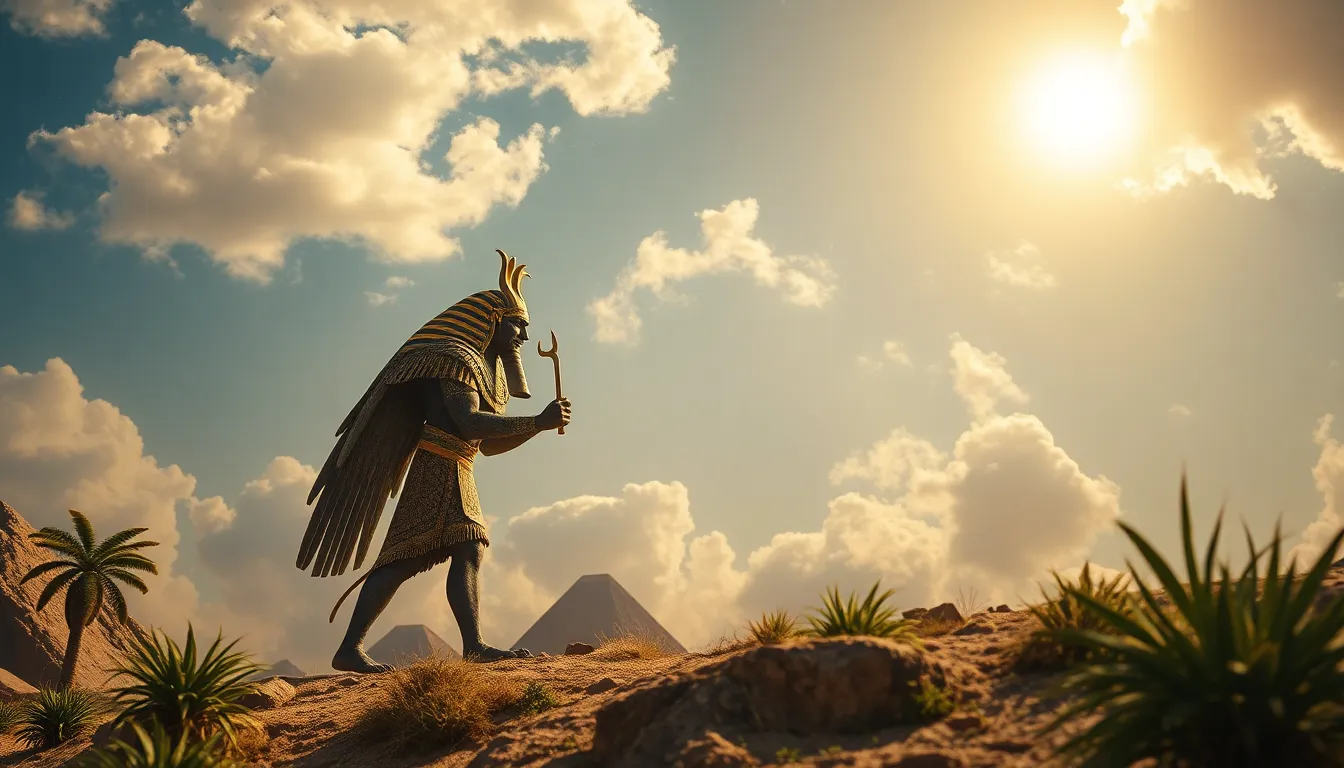The Myths of Geb and Nut: The Earth and Sky
I. Introduction
In the rich tapestry of Egyptian mythology, Geb and Nut stand out as two of the most significant deities, representing the Earth and the Sky, respectively. Their relationship is not merely one of separation but is foundational to the understanding of the natural world in ancient Egyptian cosmology. Together, they embody the duality of existence, demonstrating how the Earth and Sky interact and depend on each other.
II. The Origins of Geb and Nut
A. Creation myths and the emergence of Geb and Nut
The origins of Geb and Nut are steeped in ancient creation myths that detail the birth of the cosmos. According to these myths, in the beginning, there was only the chaotic waters of Nun. From this primordial void emerged Atum, the creator god, who fashioned himself from the waters. Atum’s first creation was the pair of deities, Shu (air) and Tefnut (moisture), who in turn gave birth to Geb and Nut.
B. The role of Atum and the Ennead in their creation
Atum is central to the Egyptian creation narrative, and he is often depicted as the first god in the Ennead, a group of nine deities revered in Heliopolitan mythology. The Ennead’s hierarchy illustrates the interconnected nature of existence and the birth of Geb and Nut symbolizes the establishment of order from chaos, with Geb representing stability and Nut embodying the limitless expanse of the sky.
III. The Symbolism of Geb: The Earth
A. Characteristics and attributes of Geb
Geb is often depicted as a man lying on his back, with green skin symbolizing vegetation and fertility. His body is associated with the earth, and he is sometimes shown with a goose, as “Geb” means “goose” in ancient Egyptian. As the god of the earth, Geb is responsible for all that grows and lives upon the land.
B. Geb’s significance in agriculture and fertility
In the agricultural society of ancient Egypt, Geb was immensely significant. He was believed to provide nourishment through crops and fertility to both land and people. Farmers prayed to Geb for bountiful harvests and protection from drought or flood, making him an essential figure in the daily lives of the ancient Egyptians.
IV. The Symbolism of Nut: The Sky
A. Characteristics and attributes of Nut
Nut is depicted as a woman arched over Geb, with her body covered in stars, representing the night sky. Her blue skin symbolizes the heavens, and she is often shown giving birth to celestial bodies. Nut’s role as the sky goddess emphasizes her connection to the cosmos and the cycles of time.
B. Nut’s role in the cycles of the heavens and celestial bodies
Nut’s significance extends beyond mere representation; she is intricately linked to the cycles of day and night. Each evening, she swallows the sun, and each morning, she gives birth to it anew, symbolizing the eternal cycle of life and death. The stars that adorn her body are seen as the souls of the deceased, further linking her to the afterlife.
V. The Relationship Between Geb and Nut
A. The myth of their separation and union
The relationship between Geb and Nut is characterized by both separation and union. According to myth, their father, Shu, separated them to create space for the world to exist. This act of separation caused great sorrow for both deities, as they longed to be together. Their eventual reunion symbolizes the balance of the universe, where the earth and sky coexist harmoniously.
B. Symbolic interpretations of their relationship
The relationship between Geb and Nut illustrates the concept of duality in Egyptian thought. They represent complementary forces: Geb as the grounding force of the earth and Nut as the expansive force of the heavens. This duality is essential for the balance of life, emphasizing the interconnectedness of all things.
VI. Myths Involving Geb and Nut
A. Notable stories and legends featuring Geb and Nut
Several myths feature Geb and Nut prominently. One of the most famous tales is that of the conflict between Set and Osiris. In this narrative, Geb plays a crucial role in the judgment of Osiris, while Nut is often invoked for her protective qualities. Their presence in these myths highlights their importance within the larger mythological framework of ancient Egypt.
B. Their roles in the greater Egyptian cosmology
Geb and Nut are integral to Egyptian cosmology, forming part of the foundational mythos that explains the creation and order of the universe. Their offspring, including Osiris, Isis, Set, and Nephthys, further develop the themes of life, death, and rebirth, enhancing their significance in Egyptian religious practices.
VII. Cultural Impact and Legacy
A. How Geb and Nut influenced ancient Egyptian art and literature
Geb and Nut’s relationship and attributes have had a profound influence on ancient Egyptian art and literature. They are often depicted in tomb paintings, illustrating the importance of the earth and sky in the afterlife. Numerous hymns and prayers were dedicated to them, reflecting their revered status among the gods.
B. Modern interpretations and adaptations of their myths
In modern times, Geb and Nut continue to capture the imagination of artists, writers, and scholars. Their stories have been reinterpreted in various forms, including literature, film, and visual arts, emphasizing themes of love, separation, and the balance of nature. These adaptations serve as a testament to their enduring legacy.
VIII. Conclusion
In summary, Geb and Nut are vital figures in Egyptian mythology, representing the fundamental forces of the Earth and Sky. Their relationship is a poignant narrative that reflects the interconnectedness of life and the natural world. As their myths continue to resonate today, they remind us of the ancient Egyptians’ profound understanding of the cosmos and the delicate balance that sustains it.




